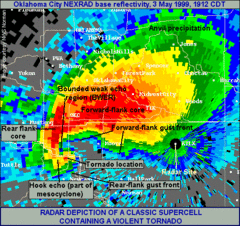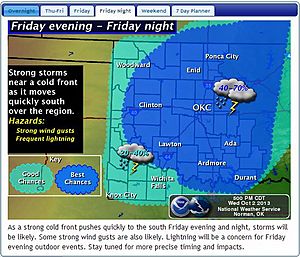National Weather Service Norman, Oklahoma facts for kids
 |
|
 The National Weather Center complex, which has housed the NWS Norman office since the facility opened in 2006. |
|
| Agency overview | |
|---|---|
| Formed | November 1, 1890 |
| Preceding agencies |
|
| Jurisdiction | Federal Government of the United States |
| Headquarters | 120 David L Boren Blvd, Norman, Oklahoma 73072 35°10′55″N 97°26′24″W / 35.182°N 97.440°W |
| Employees | 25 |
| Agency executives |
|
| Parent agency | National Weather Service (operating as a branch of the NWS Southern Region Headquarters) |
National Weather Service - Norman, Oklahoma (office identification code: OUN) is a Weather Forecast Office (WFO) of the National Weather Service based in Norman, Oklahoma, which is responsible for forecasts and the dissemination of weather warnings and advisories for central and most of western Oklahoma (with the exception of the panhandle), and western portions of north Texas. It is located in the National Weather Center on the University of Oklahoma campus, where it acts as one of the NOAA Weather Partners, a group of close-together weather-related agencies of the National Oceanic and Atmospheric Administration. NWS Norman is currently overseen by David Andra, who serves as the Meteorologist In Charge of the office.
The Norman Weather Forecast Office – which operates as a branch of the National Weather Service's Southern Region Headquarters (SRH) division – manages three NEXRAD (WSR-88D) Doppler weather radar sites that cover its area of forecasting responsibility, based in Oklahoma City (radar identification code: TLX), serving central Oklahoma; Frederick (FDR), serving southwestern Oklahoma and western north Texas; and at Vance Air Force Base (VNX), serving north-central and northwestern parts of Oklahoma, and portions of southern Kansas. The office has earned widespread recognition from local media outlets, especially in concern with certain weather conditions that are or are forecast to occur. It has also received attention from national media, and was even recognized by United States President Barack Obama.
History
Location
The U.S. Weather Bureau created the Central Oklahoma forecast office on November 1, 1890; it was originally based in Oklahoma City at the Overholser Opera House, on the southeast corner of Robinson Avenue and Grand Boulevard in the city's downtown district. Twelve years later, the Weather Bureau relocated the Oklahoma City office's operations to the Culbertson Building, at the southeast corner of Grand and Broadway Avenue, where it began operating from on July 1, 1902 (the former location at the Overholser Opera House was eventually demolished in 1964; the Cox Convention Center was later built on the property, where it remains to this day).
The offices at the Culbertson Building was closed four years later on January 16, 1906, with the operations moving once again, this time to a newly constructed weather observatory located at 1923 Classen Boulevard in southwest Oklahoma City. In 1932, the office began to slowly migrate its forecasting operations and other functions from the observatory to a new Weather Bureau office based in an existing building at Will Rogers Airport on the city's southwestern edge, which opened on April 2 of that year. Eventually, an actual proprietary building to solely house the Weather Bureau office was constructed at the airport, where it moved on October 22, 1965. Shortly afterward, the U.S. Weather Bureau was renamed the National Weather Service (NWS). On January 27, 1987, the National Weather Service moved its central Oklahoma office away from Oklahoma City (and Oklahoma County), and relocated its operations into a building that had been constructed specifically for NWS use in Cleveland County, at Max Westheimer Airport (now the University of Oklahoma Westheimer Airport) in Norman.
The National Severe Storms Laboratory (NSSL) followed the central Oklahoma office there in 1990. Then, in October 1995, the National Severe Storms Forecast Center – was subsequently renamed the Storm Prediction Center (SPC) – migrated its operations from Kansas City, Missouri to a wing of the Max Westheimer Airport campus. On August 7, 2006, the National Weather Service office, the Storm Prediction Center and the National Severe Storms Laboratory began moving their respective operations into the newly constructed National Weather Center building on the southern portion of the University of Oklahoma's Research Campus.
Weather forecasting
The Norman Weather Forecast Office handles responsibility for the general forecasting and the issuance of watches, warnings and advisories for hazardous weather conditions for 48 counties in Oklahoma and eight counties in western north Texas (with major cities served by the office including Oklahoma City, Lawton, Enid and Wichita Falls). Though, as the Storm Prediction Center is responsible for issuing severe thunderstorm and tornado watches, the Norman WFO only composes outline and status updates for SPC-issued watches affecting any portion of its designated County Warning Area.

Under NOAA operational guidelines for such situations, responsibility over the issuance of forecasts – both routine and short-term – and weather alert products can be transferred to the National Weather Service office in Tulsa in the event of an outage (such as a computer system failure or building-wide power disruption) or an emergency necessitating the enactment of evacuation procedures for NWS and guidance center personnel (such as an approaching strong tornadic circulation or tornado on the ground) that affects the Norman campus.
The forecast office has been responsible for advance warning dissemination and short-term forecasting during many severe weather and winter weather events that have happened within the County Warning Area, including notable tornado outbreaks and other significant weather events that the Norman office's area of responsibility has been the site of.
During the first week of May 1999, a major tornado outbreak affected portions of the Central and Southeastern United States, with the most severe activity impacting much of Oklahoma – especially locations within the Norman County Warning Area – on the late-afternoon and evening of May 3. The ninth tornado produced by the first supercell was the most significant, becoming the first tornado recorded to have produced damage costs surpassing US$1 billion. This tornado affected much of the southern portion of the Oklahoma City metropolitan area, and as it progressed over Bridge Creek in northeastern Grady County, a mobile Doppler on Wheels radar recorded maximum wind speeds within the tornado at upper elevations at 301 ± 20 mph (484 ± 32 km/h), among the highest winds known to have ever been observed on or near the Earth's surface.
At 6:57 p.m. Central Time that evening, as the tornado tracked near Newcastle, the Norman office disseminated the first tornado emergency ever issued by the National Weather Service for Moore and southern Oklahoma City; the enhanced warning statement – which in its initial version, was issued as a separate Severe Weather Statement, and is now incorporated within a newly issued or a Special Weather Statement on an existing tornado warning to denote a damaging tornado affecting densely populated areas – was drafted by staff meteorologist David Andra, in order to convey to the public and local media outlets the heightened danger and imminent impact of the destructive tornado.
Websites
The National Weather Service Weather Forecast Office in Norman maintains a multitude of websites available to the public, which provide weather information for the Norman forecast area of responsibility. The Norman office's subpage within the main Weather.gov website includes a main page that contains a variety of information, including, but not limited to, pages featuring current conditions and extended point forecasts for cities served by the office, which can also be accessed through a point map that features active watches, warnings and advisories for the western two-thirds of Oklahoma and western north Texas; an updated roundup of weather observations throughout the County Warning Area at the current hour; information about past and present events involving the Norman forecast area; and, generally, a text-based Hazardous Weather Outlook.
The NWS Norman office also operates social media accounts on Facebook and Twitter to provide short-term forecasts and weather alert information.
Local map
Among the features included by the Norman office's website is a localized forecast map that is accessible from its front page (similar to others that exist on the sites of other offices operating within the Southern Region Headquarters), which typically outlines current weather observations and forecasted weather conditions over the next two to five days within the Norman Forecast Area, and a diagram depicting a generalized seven-day forecast for the region (accessible through a selection of tabs which varies depending on the conditions expected). However, specialized maps are sometimes incorporated for expected hazardous weather events, including regionalized outlines of SPC-issued severe thunderstorm risk threats, and estimated precipitation amounts for upcoming and ongoing hydrological and winter weather events.
Observation data
The Norman office's website contains a list of Automated Surface Observing System sites overseen by the National Weather Service within its area of forecasting responsibility, which can be accessed through either the main page of the current weather subpage of the site. These include landing pages containing a log of observation data collected over the past three days at individual sites in region, with updated information generally being added at constant intervals that vary depending on each location.



